

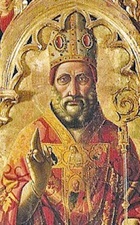
Three entries in the Roman Martyrology read:
-
✴under 30th July: “At Assisi in Umbria, St Rufinus, martyr”;
-
✴under 11th August: “ ... the martyrdom of St Rufinus, Bishop of the Marsi, and his companions, under Emperor Maximinus”; and
-
✴under 31st August: “At Transaco [Trasacco] , in the Marches near Lake Fucino, the birthday of the holy martyrs Caesidius [or Cesidius], priest, and his companions, who were crowned with martyrdom in the persecution of Maximinus.
These records reflect a confused situation set out below. In short, the date of 30th July for the feast of St Rufinus at Assisi is probably due to a transcription error (see below). According to a legend commissioned from Assisi in ca. 1050 (see below):
-
✴St Rufinus was martyred at Assisi on 11th August; and
-
✴his son, St Cesidius was martyred at Trasacco on 31st August.
Sermon of St Peter Damian
The earliest surviving literary source for the cult of St Rufinus derives from a sermon of St Peter Damian (BHL 7369) entitled “Miracula beatissimi Rufini martyris” (Miracles of the blessed martyr Rufinus). It dealt primarily with the miracles that had attended the translation of an abandoned sarcophagus that had once contained the relics of St Rufinus and was written in ca. 1060.
The sermon describes the situation just before the translation:
-
✴St Rufinus had originally been buried on the site of his martyrdom, outside Assisi.
-
✴His relics had been moved within the walls of Assisi at an early date "through fear of pagan attack", and the original sarcophagus had been abandoned outside the city.
-
✴By the time of Bishop Ugone (ca. 1029-59), the relics were housed in a “parva basilica” (small hall). Nothing was known about the life of St Rufinus, whose feast was celebrated on the date that this basilica had been dedicated to him.
Bishop Ugone decided to translate the abandoned sarcophagus to Santa Maria Maggiore, the episcopal church of Assisi: “Since the mother church did not have the martyr’s body, at least it might be compensated by the consolation of his empty tomb”. However, the people wanted to reunite the sarcophagus with the relics. Thus, when the men carrying the sarcophagus arrived “at a certain crossroads”, the people rioted. St Rufinus miraculously came to their aid, and while some 60 of Bishop Ugone’s men could no longer move the sarcophagus, only six men were needed to divert it to the small basilica.
The crossroads where all this happened was almost certainly at the site of the present Arco di Santa Chiara (see Walk II), which was then outside the city walls. The road ahead led to the Piazza del Comune; that to the left led to Porta Moiano and Santa Maria Maggiore; and that to the right led to the small basilica in Piazza San Rufino.
These events led to upsurge in the cult of the saint. Bishop Ugone built a large church to replace the small basilica, reunited the relics with their sarcophagus, and consecrated an altar over them. “Divine inspiration” led to the discovery of a legend of St Rufinus, and this included the information that the date of the martyrdom: a number of the transcriptions of the sermon give this as “tertio kalendas augusti” (30th July), but this seems to have been a misprint for “tertio idus augusti” (11th August).
Legend of St Rufinus
The “Passio sancti Rufini episcopi et Cesidii presbiteri filii eius” (Legend of St Rufinus bishop, and his son, St Cesidius, priest), which Bishop Ugone discovered, was known to St Peter Damian: he used it as the basis of a hymn that he wrote in honour of St Rufinus:
-
✴The oldest surviving copy is probably that in the archives of San Lorenzo, Perugia (BHL 7362), which probably dates to the late 11th century.
-
✴There is a slightly later one in the archives of San Rufino, Assisi, (BHL 7364).
-
✴A copy that was in the archives of San Lorenzo, Spello until at least 1797 was subsequently lost.
-
✴Other copies survive in the Biblioteca Vaticana, Rome and the Biblioteca Brancacciana, Naples.
The author of this legend gives his name as Georgius, a monk from Rome who was writing in his monastery at Anagni at the request of an old man called Maurinus (who had presumably been sent by Bishop Ugone). He records that St Rufinus had been Bishop of Amasia in Pontus (Asia Minor) before fleeing to Trasacco in Marsia (southern Italy) with his son St Cesidius. He consecrated a church there which he left in the care of St Cesidius when he moved to Assisi. St Cesidius was subsequently martyred on 18th July (Perugia) or 31st August (Assisi and Spello).
In Assisi, St Rufinus fell foul of the urban consul Aspasius, and was arrested and tortured. He survived an attempt to burn him alive and was then drowned with a mill stone around his neck. The manuscript from Perugia gives the date using the modern calendar: “mense augusto die XI” (11th August).
This legend is clearly of no historic value. Two particular difficulties with it are worthy of note:
-
✴The legend refers to St Rufinus as a bishop, but it does not say that he was Bishop of Assisi. Nevertheless, Bishop Ugone generally signed himself “Ugo episcopus vicarious Sancti Rufini”, suggesting that he regarded St Rufinus as the first of the city's bishops, and this is how he is still generally described.
-
✴The legend is set in the reign of an emperor given variously as Domnino (Perugia), Dagno (Assisi) or Domno (Spello), but no such emperor ever existed.
However, it is clear that St Rufinus was venerated at Assisi from an early date. A church dedicated to him at Costano (11 km south west of Assisi) was documented in 1038. Excavations carried out in the locality in 1854 discovered what seem to be the remains of this church and of an early Christian cemetery. Local historians have suggested that this is where St Rufinus was buried after his drowning in the nearby Chiascio river.
St Cesidius
The church dedicated to SS Rufino e Cesidio at Trasacco was first documented as simply San Cesidio in 1096. Another document of 1120 named it as SS Cesidio e Rufino. The feast of St Cesidius and companions was celebrated here on 31st August: the separate celebration of the feast of St Rufinus on 11th August was introduced only after the publication of the Roman Martyrology in 1586.
Two relevant legends from Trasacco throw some light on the confused entries in the Roman Martyrology:
-
✴The Miracula S. Caesidii (BHL 7370), which was probably written in the 11th century, records the miracles that attended the burial of St Cesidius at Trasacco. It also says that the original church was destroyed by pagans (presumably Hungarians and/or Saracens) and rebuilt (presumably in the 11th century).
-
✴A legend of SS Rufinus and Cesidius (BHL 7361) seems to be an elaboration of that from Assisi (BHL 7362 and 7364): it agrees that SS Rufinus and Cesidius came from Amasia in Pontus; that they established a church at Trasacco; and that they were martyred at, respectively, Assisi and Trasacco. This legend is set in the reign of the Emperor Maximian.
Relics of St Rufinus
The history of the relics of St Rufinus at Assisi has been described above, up until the point that they were interred under the high altar of Bishop Ugone’s church in ca. 1050. Two other relevant legends exist in the archives of Assisi: these were almost certainly by the same author and were written after 1317 (since one of them mentions the Porta San Pietro, which did not exist until the second circuit of walls was built).
-
✴According to the “Inventio prima” (BHL 7366), the body of St Rufinus was found some years after his execution, when a farmer saw a light from the in the river “Chiagio”. This event pre-dated the rediscovery of the relics in 1212 (see below) by 800 years (i.e. it happened in 412).
-
✴According to the “Inventio secunda” (BHL 7367), describes the events of 1212, when the custodian of the hospice attached to San Rufino had a dream that allowed him to guide Bishop Guido to the relics, which were submerged in water in the crypt of the present church. Bishop Guido translated them to its altar in a ceremony that was attended by the consuls and the people of Assisi as well as visitors from other cities. When some of these tried to leave carrying dust from the relics, they were stopped in their tracks until all this dust was returned to the sarcophagus. This account underlines the claims of the people of Assisi to the relics of St Rufinus in their entirety.
It is now possible to assemble a quasi-historical account of the relics of St Rufinus:
-
✴The Inventio prima asserts that they were discovered in the Chiascio river in 412.
-
✴St Peter Damian’s sermon records that they were moved within the walls of Assisi at an early date "through fear of pagan attack", and housed in a parva basilica. A relief (probably 8th century) in the portal of San Rufino may have come from this basilica, which would suggest that the translation of the relics into Assisi occurred during the Lombard invasion.
-
✴St Peter Damian’s sermon also records that the original sarcophagus lay abandoned outside the city until Bishop Ugone (ca. 1029-59) reunited it with the relics. He built a new church (see Bishop Ugone’s church) and placed the relics and their sarcophagus under its altar.
-
✴The construction of the present church of San Rufino began in 1140, but was still unfinished in 121o, when the terms of the peace signed between the warring factions of Assisi provided for the resumption of the construction project. The relics of St Rufinus must have been lost during the disruption caused by the building work and the civil war, because the “Inventio secunda” asserts that Bishop Guido rediscovered them under water in the crypt of the new church in 1212 and translated them to its altar.
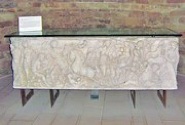
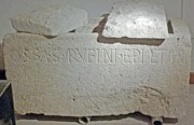
Two sarcophagi are traditionally associated with the relics of San Rufino:
-
✴The Roman sarcophagus illustrated above on the left is reputed to be the original one that was abandoned outside the city when the relics were translated to the first church of San Rufino in ca. 800. It was reunited with the relics in the 11th century, following the miraculous evens described above that prompted Bishop Ugone to build his church. It is now in the crypt of Bishop Ugone’s church.
-
✴The smaller container illustrated to the right, which bears the inscription “OSSA S RUFINI EPI ET [M]ART” (bones of St Rufinus, bishop and martyr). It presumably then held the relics from the time of their arrival in Assisi until the time that they were returned to the original sarcophagus. It is now in the Museo Diocesano.
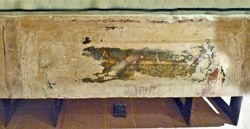
The relics (and presumably therefore the sarcophagus) were subsequently lost until 1212, when they were rediscovered in the crypt under the apse of the present church and translated to its altar. The original sarcophagus has a damaged fresco of the supine St Rufinus on the back, which is associated with a payment made to “maestro Rafaello” (probably Raffaellino del Colle) in 1556. This suggests that the sarcophagus still housed the relics at that point.
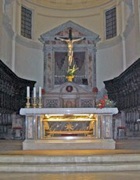
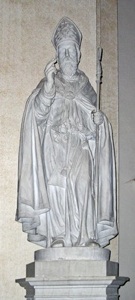
Read more:
A. Brunacci, "Leggende e Culto di San Rufino in Assisi" in
F. Santucci (Ed.), "La Cattedrale di San Rufino in Assisi", (1999) Assisi
Relevant sections of the sermon of St Peter Damian are translated into English in:
R. Brown, "The Roots of St Francis", (1982) Chicago
Return to Saints of Assisi.
Return to the home page on Assisi.

